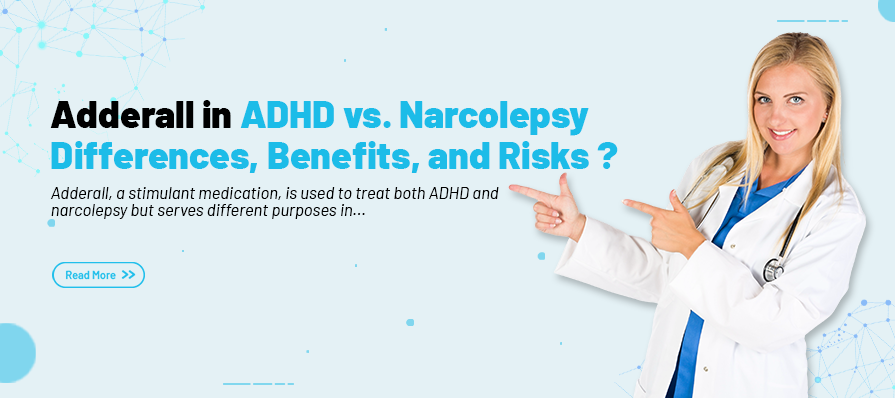Adderall is one of the most commonly prescribed stimulant medications in the United States, widely used to treat Attention Deficit Hyperactivity Disorder (ADHD) and Adderall in ADHD vs. Narcolepsy. At StreetDrugStore.com, we believe in empowering our readers with clear, accurate, and evidence-based information. This article breaks down its advantages, potential risks, and what patients and caregivers should know before starting or continuing treatment.
What Is Adderall?
Adderall is a prescription stimulant that works by activating the central nervous system, using a blend of two active ingredients—amphetamine and dextroamphetamine—to enhance focus, alertness, and energy levels. These ingredients are classified as Schedule II controlled substances due to their high potential for abuse and dependence. Adderall is offered in two main forms: a fast-acting version known as immediate-release (IR), and a longer-lasting option called extended-release (XR), each designed to meet different treatment needs.
Adderall works by increasing levels of dopamine and norepinephrine in the brain, two neurotransmitters crucial for attention, focus, energy, and wakefulness.
Adderall for ADHD
What Is ADHD?
ADHD is a brain-based condition that affects how individuals focus, control impulses, and manage energy levels, often leading to challenges with attention, self-regulation, and activity levels that persist over time. It affects both children and adults, though symptoms may manifest differently across ages.
How Adderall Helps ADHD
In people with ADHD, Adderall helps regulate and stimulate underactive brain areas, particularly those involved in executive function. Contrary to popular belief, stimulants like Adderall do not “overstimulate” those with ADHD. Instead, they help correct chemical imbalances and improve cognitive function.
Benefits of ADHD
- Improved focus and attention
- Reduction in impulsive behaviors
- Increased task completion and organization
- Better academic or work performance
- Improved social interactions
For many, the effects can be noticeable within 30 to 60 minutes and last between 4-6 hours (IR) or up to 12 hours (XR).
Common Dosages for ADHD
- Children (6+): Usually start with 5 mg once or twice daily
- Adults: May begin at 10 mg daily, titrated based on response
The dosage is typically adjusted to balance effectiveness with side effects.
Adderall for Narcolepsy
What Is Narcolepsy?
Narcolepsy is a chronic sleep disorder marked by excessive daytime sleepiness, sudden loss of muscle tone (cataplexy), sleep paralysis, and hallucinations. It can severely affect a person’s ability to function during the day.
How Adderall Helps Narcolepsy
In narcolepsy, Adderall is used as a wakefulness-promoting agent, helping patients stay alert during the day. Unlike in ADHD, where it treats attention and executive function issues, in narcolepsy, it combats debilitating fatigue and daytime sleep attacks.
Benefits of Narcolepsy
- Reduces excessive daytime sleepiness
- Improves alertness
- Enhances the ability to participate in daily activities
Common Dosages for Narcolepsy
- Initial dose: Usually 10 mg in the morning
- Ongoing treatment may involve gradually increasing the dose, with some individuals requiring up to 60 mg daily, typically split into two or three administrations throughout the day for sustained effectiveness.
Narcolepsy patients often need higher dosages compared to ADHD patients due to the severity of sleep disruptions.
Key Differences in Usage: ADHD vs. Narcolepsy
AspectADHDNarcolepsy
Primary Goal: Improve focus and reduce impulsivity. Promote wakefulness and reduce sleepiness.
Typical Dosage: Lower, tailored to cognitive needs. Often higher, based on sleep disruption.
Treatment Duration: Often long-term, starting in childhood. Often long-term, diagnosed in adolescence/adulthood.
Response Time: Fast—30 to 60 mins Fast—30 to 60 mins
Formulation Used: IR or XR, depending on lifestyle. Usually, IR for flexible dosing.
Common Side Effects
- Insomnia
- Dry mouth
- Increased heart rate
- Anxiety or irritability
- Decreased appetite
- Weight loss
- Headaches
ADHD vs. Narcolepsy Risk Profiles
People with ADHD are more likely to misuse Adderall recreationally or for performance enhancement. In contrast, narcolepsy patients often take it strictly to function, making abuse less likely but still possible.
Misuse and Abuse: A Growing Concern
Adderall is commonly misused by college students and professionals looking to enhance performance, even without an ADHD diagnosis. This off-label use is not only illegal but also dangerous.
Misuse can lead to:
- Heart issues
- Psychosis
- Dependency
- Withdrawal symptoms
- Legal consequences
At StreetDrugStore.com, we strongly advocate for prescription-only, medically supervised use of Adderall.
Who Should Avoid Adderall?
Adderall may not be suitable for individuals with:
- A history of drug abuse
- Severe anxiety disorders
- Heart conditions
- Hyperthyroidism
- Glaucoma
- Bipolar disorder (without mood stabilization)
Always consult a qualified healthcare provider before starting Adderall or any stimulant.
Alternatives to Adderall
For ADHD:
- Ritalin (methylphenidate)
- Strattera (atomoxetine) – Non-stimulant
- Vyvanse (lisdexamfetamine)
- Behavioral therapy and lifestyle changes
For Narcolepsy:
- Modafinil (Provigil) – Often preferred for fewer side effects
- Sodium oxybate (Xyrem) – Especially in cataplexy
- Lifestyle interventions – Sleep hygiene, scheduled naps
Not everyone responds to Adderall the same way. Finding the right treatment often requires trial and error under medical supervision.
Tips for Safe and Effective Use
- Stick to prescribed doses
- Take at the same time daily to avoid sleep disruptions
- Avoid caffeine and alcohol while on Adderall
- Monitor blood pressure and heart rate regularly
- Report any unusual mood changes to your doctor
- Do not abruptly stop taking it—withdrawal symptoms are real
- Store securely—keep away from children or potential misuse
Final Thoughts
Adderall is a powerful medication with life-changing benefits when used correctly. In ADHD, it helps balance brain chemicals responsible for focus and self-regulation. In narcolepsy, it restores wakefulness and allows patients to participate more fully in daily life. But it’s not without its risks, especially when misused or taken without supervision.
At StreetDrugStore.com, we emphasize informed, responsible use of all medications. Whether you’re considering Adderall for ADHD or narcolepsy—or supporting someone who is—understanding the differences, benefits, and potential drawbacks is the first step to safe and successful treatment.

